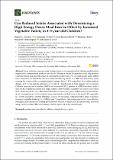Files in this item
Can reduced intake associated with downsizing of a high energy dense meal item be offset by increased vegetable variety in 3-5-year-old children?
Item metadata
| dc.contributor.author | Carstairs, Sharon A. | |
| dc.contributor.author | Caton, Samantha J | |
| dc.contributor.author | Blundell-Birtill, Pamela | |
| dc.contributor.author | Rolls, Barbara J. | |
| dc.contributor.author | Hetherington, Marion M. | |
| dc.contributor.author | Cecil, Joanne E. | |
| dc.date.accessioned | 2018-12-04T14:30:12Z | |
| dc.date.available | 2018-12-04T14:30:12Z | |
| dc.date.issued | 2018-12-03 | |
| dc.identifier | 256681962 | |
| dc.identifier | 1b967abf-a98d-4d81-9b4f-8ccf46ec1b19 | |
| dc.identifier | 85057969637 | |
| dc.identifier | 000455073200060 | |
| dc.identifier.citation | Carstairs , S A , Caton , S J , Blundell-Birtill , P , Rolls , B J , Hetherington , M M & Cecil , J E 2018 , ' Can reduced intake associated with downsizing of a high energy dense meal item be offset by increased vegetable variety in 3-5-year-old children? ' , Nutrients , vol. 10 , no. 12 , 1879 . https://doi.org/10.3390/nu10121879 | en |
| dc.identifier.issn | 2072-6643 | |
| dc.identifier.other | ORCID: /0000-0001-6593-5972/work/51470243 | |
| dc.identifier.other | ORCID: /0000-0003-4779-6037/work/60196853 | |
| dc.identifier.uri | https://hdl.handle.net/10023/16621 | |
| dc.description | This work was supported by the BBSRC, Diet and Nutrition Research Industry Club [grant numbers BB/M027384/1]. | en |
| dc.description.abstract | Large portions of energy dense foods promote overconsumption but offering small portions might lead to compensatory intake of other foods. Offering a variety of vegetables could help promote vegetable intake and offset the effect of reducing the portion size (PS) of a high energy dense (HED) food. Therefore, we tested the effect on intake of reducing the PS of a HED unit lunch item while varying the variety of the accompanying low energy dense (LED) vegetables. In a within-subjects design, 43 3–5-year-old pre-schoolers were served a lunch meal in their nursery on 8 occasions. Children were served a standard (100%) or downsized (60%) portion of a HED sandwich with a side of LED vegetables offered as a single (carrot, cherry tomato, cucumber) or variety (all 3 types) item. Reducing the PS of a HED sandwich reduced sandwich (g) (p < 0.001) and total meal intake (kcal) consumption (p = 0.001) without an increased intake of other foods in the meal (LED vegetables (p = 0.169); dessert (p = 0.835)). Offering a variety of vegetables, compared with a single vegetable, increased vegetable intake (g) (p = 0.003) across PS conditions. Downsizing and variety were effective strategies individually for altering pre-schoolers’ intakes of HED and LED meal items, however, using variety to offset HED downsizing was not supported in the present study. | |
| dc.format.extent | 15 | |
| dc.format.extent | 1234715 | |
| dc.language.iso | eng | |
| dc.relation.ispartof | Nutrients | en |
| dc.subject | Portion size | en |
| dc.subject | Pre-school children | en |
| dc.subject | Eating behavior | en |
| dc.subject | Variety | en |
| dc.subject | RA0421 Public health. Hygiene. Preventive Medicine | en |
| dc.subject | RJ Pediatrics | en |
| dc.subject | NDAS | en |
| dc.subject | BDC | en |
| dc.subject | R2C | en |
| dc.subject | SDG 3 - Good Health and Well-being | en |
| dc.subject.lcc | RA0421 | en |
| dc.subject.lcc | RJ | en |
| dc.title | Can reduced intake associated with downsizing of a high energy dense meal item be offset by increased vegetable variety in 3-5-year-old children? | en |
| dc.type | Journal article | en |
| dc.contributor.sponsor | BBSRC | en |
| dc.contributor.institution | University of St Andrews. Population and Behavioural Science Division | en |
| dc.contributor.institution | University of St Andrews. School of Medicine | en |
| dc.contributor.institution | University of St Andrews. Health Psychology | en |
| dc.identifier.doi | 10.3390/nu10121879 | |
| dc.description.status | Peer reviewed | en |
| dc.identifier.grantnumber | BB/M027384/1 | en |
This item appears in the following Collection(s)
Items in the St Andrews Research Repository are protected by copyright, with all rights reserved, unless otherwise indicated.

